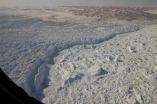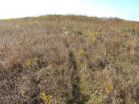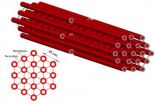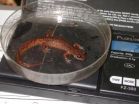(Press-News.org) Research using NASA data is giving new insight into one of the processes causing Greenland's ice sheet to lose mass. A team of scientists used satellite observations and ice thickness measurements gathered by NASA's Operation IceBridge to calculate the rate at which ice flows through Greenland's glaciers into the ocean. The findings of this research give a clearer picture of how glacier flow affects the Greenland Ice Sheet and shows that this dynamic process is dominated by a small number of glaciers.
Over the past few years, Operation IceBridge measured the thickness of many of Greenland's glaciers, which allowed researchers to make a more accurate calculation of ice discharge rates. In a new study published in the journal Geophysical Research Letters, researchers calculated ice discharge rates for 178 Greenland glaciers more than one kilometer (0.62 miles) wide.
Ice sheets grow when snow accumulates and is compacted into ice. They lose mass when ice and snow at the surface melts and runs off and when glaciers at the coast discharge ice into the ocean. The difference between yearly snowfall on an ice sheet and the sum of melting and discharge is called a mass budget. When these factors are equal, the mass budget is balanced, but for years the Greenland Ice Sheet has had a negative mass budget, meaning the ice sheet is losing mass overall.
For years the processes of surface melt and glacier discharge were roughly equal in size, but around 2006 surface melt increased and now exceeds iceberg production. In recent years, computer model projections have shown an increasing dominance of surface melt, but a limited amount of glacier thickness data made pinpointing a figure for ice discharge difficult.
Ice discharge is controlled by three major factors: ice thickness, glacier valley shape and ice velocity. Researchers used data from IceBridge's ice-penetrating radar – the Multichannel Coherent Radar Depth Sounder, or MCoRDS, which is operated by the Center for Remote Sensing of Ice Sheets at the University of Kansas, Lawrence, Kan. – to determine ice thickness and sub-glacial terrain, and images from satellite sources such as Landsat and Terra to calculate velocity. The team used several years of observations to ensure accuracy. "Glacier discharge may vary considerably between years," said Ellyn Enderlin, glaciologist at the University of Maine, Orono, Maine and the study's lead author. "Annual changes in speed and thickness must be taken into account."
Being able to study Greenland in such a large and detailed scale is one of IceBridge's strengths. "IceBridge has collected so much data on elevation and thickness that we can now do analysis down to the individual glacier level and do it for the entire ice sheet," said Michael Studinger, IceBridge project scientist at NASA's Goddard Space Flight Center in Greenbelt, Md. "We can now quantify contributions from the different processes that contribute to ice loss."
With data on glacier size, shape and speed, researchers could calculate each glacier's contribution to Greenland's mass loss and the total volume of ice being discharged from the Greenland Ice Sheet. Of the 178 glaciers studied, 15 accounted for more than three-quarters of ice discharged since 2000, and four accounted for roughly half. Considering the large size of some of Greenland's glacier basins, such as the areas drained by the Jakobshavn, Helheim and Kangerdlugssuaq glaciers, this was not exactly surprising.
What they also found was that the size of these basins did not necessarily correlate with glacier discharge rate, shuffling the order of Greenland's largest glaciers. Previously Helheim Glacier was thought to be Greenland's third largest glacier, but this study puts it in fifth place and adds two southeast Greenland glaciers, Koge Bugt and Ikertivaq South to the list of big ice-movers.
Glacier thickness measurements and this study's calculation methods have the potential to improve future computer model projections of the Greenland Ice Sheet. And with a new picture of which glaciers contribute most to mass loss, IceBridge will be able to more effectively target areas in future campaigns, promising more and better data to add to the research community's body of knowledge.
INFORMATION:
For more information on NASA's Operation Ice Bridge, visit:
http://www.nasa.gov/icebridge
NASA data shed new light on changing Greenland ice
2014-03-10
ELSE PRESS RELEASES FROM THIS DATE:
Shade will be a precious resource to lizards in a warming world
2014-03-10
Climate change may even test lizards' famous ability to tolerate and escape the heat -- making habitat protection increasingly vital -- according to a new study by UBC and international biodiversity experts.
The study, published today in the Proceedings of the National Academy of Sciences, looks at the heat and cold tolerance of 296 species of reptiles, insects and amphibians, known as ectotherms. The researchers discovered that regardless of latitude or elevation, cold-blooded animals across the world have similar heat tolerance limits. However, species in the tropics ...
A tale of 2 data sets: New DNA analysis strategy helps researchers cut through the dirt
2014-03-10
For soil microbiology, it is the best of times. While no one has undertaken an accurate census, a spoonful of soil holds hundreds of billions of microbial cells, encompassing thousands of species. "It's one of the most diverse microbial habitats on Earth, yet we know surprisingly little about the identities and functions of the microbes inhabiting soil," said Jim Tiedje, Distinguished Professor at the Center for Microbial Ecology at Michigan State University. Tiedje, along with MSU colleagues and collaborators from the U.S. Department of Energy Joint Genome Institute (DOE ...
Mecasermin (rh-IGF-1) treatment for Rett Syndrome is safe and well-tolerated
2014-03-10
(Cincinnati, OH) – The results from Boston Children's Hospital's Phase 1 human clinical trial in Rett syndrome came out today. A team of investigators successfully completed a Phase 1 clinical trial using mecasermin [recombinant human insulin-like growth factor 1 (IGF-1)], showing proof-of-principle that treatments like IGF-1 which are based on the neurobiology of Rett syndrome, are possible. The study deemed that IGF-1 is safe and well tolerated in girls diagnosed with Rett syndrome, and the data also suggests that certain breathing and behavioral symptoms associated ...
National study reveals urban lawn care habits
2014-03-10
(Millbrook, NY) What do people living in Boston, Baltimore, Miami, Minneapolis-St. Paul, Phoenix, and Los Angeles have in common? From coast to coast, prairie to desert – residential lawns reign.
But, according to a new study in the Proceedings of the National Academy of Sciences, beneath this sea of green lie unexpected differences in fertilization and irrigation practices. Understanding urban lawn care is vital to sustainability planning, more than 80% of Americans live in cities and their suburbs, and these numbers continue to grow.
The study was undertaken to ...
Lower IQ in teen years increases risk of early-onset dementia
2014-03-10
Men who at the age of 18 years have poorer cardiovascular fitness and/or a lower IQ more often suffer from dementia before the age of 60. This is shown in a recent study encompassing more than one million Swedish men.
In several extensive studies, researchers at the Sahlgrenska Academy of Gothenburg University have previously analyzed Swedish men's conscription results and were able to show a correlation between cardiovascular fitness as a teenager and health problems in later life.
Increased risk for early-onset dementia
In their latest study, based on data from 1.1 ...
Some characteristics increase the likelihood of getting married and living together
2014-03-10
CORAL GABLES, FL (March 10, 2014) -- When it comes to romantic relationships, attributes such as health, kindness, and social status have been shown to be important qualities in choosing a partner. It may be surprising to learn, however, that certain personal traits predispose a person towards either getting married or forming a cohabitating relationship.
According to a study recently published in the journal Social Science Research, scoring high on attractiveness, personality, and grooming is associated with a greater probability of entering into a marital relationship ...
A shocking diet
2014-03-10
There have been plenty of fad diets that captured the public's imagination over the years, but Harvard scientists have identified what may be the strangest of them all – sunlight and electricity.
Led by Peter Girguis, the John L. Loeb Associate Professor of the Natural Sciences, and Arpita Bose, a post-doctoral fellow in Organismic and Evolutionary Biology, a team of researchers showed that the commonly found bacterium Rhodopseudomonas palustris can use natural conductivity to pull electrons from minerals located deep in soil and sediment while remaining at the surface, ...
Ben-Gurion U. researchers identify severe genetic disease prevalent in Moroccan Jews
2014-03-10
BEER-SHEVA, Israel, March 10, 2014 - Ben-Gurion University of the Negev (BGU) researchers have unraveled the genetic basis of a hereditary disease that causes severe brain atrophy, mental retardation and epilepsy in Jews of Moroccan ancestry, according to a study published this week online in the Journal of Medical Genetics.
The disease, which the researchers have called PCCA2 (Progressive Cerebello-Cerebral Atrophy Type 2), is caused by two mutations in the VPS53 gene. It results in defective circulation of vacuoles (endosomes) within patents' cells and leads to detrimental ...
Penn researchers model a key breaking point involved in traumatic brain injury
2014-03-10
Even the mildest form of a traumatic brain injury, better known as a concussion, can deal permanent, irreparable damage. Now, an interdisciplinary team of researchers at the University of Pennsylvania is using mathematical modeling to better understand the mechanisms at play in this kind of injury, with an eye toward protecting the brain from its long-term consequences.
Their recent findings, published in the Biophysical Journal, shed new light on the mechanical properties of a critical brain protein and its role in the elasticity of axons, the long, tendril-like part ...
Predation on invertebrates by woodland salamanders increases carbon capture
2014-03-10
ARCATA, Calif.—Woodland salamanders perform a vital ecological service in American forests by helping to mitigate the impacts of global warming.
Global warming occurs when greenhouse gases like carbon dioxide are released into the atmosphere. Woodland salamanders facilitate the capture of this carbon before it is released by feeding on invertebrates (beetles, earthworms, snails, ants, etc.) that would otherwise release carbon through consumption of fallen leaves and other forest debris. Woodland salamanders are the most common vertebrate species in American forests; consequently, ...






